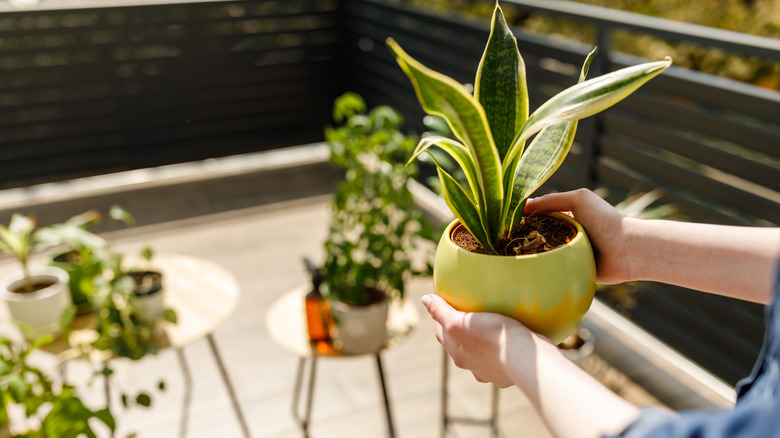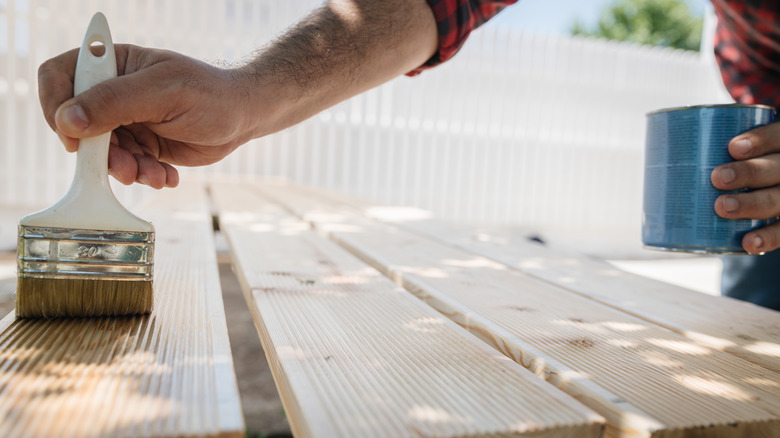Handy Ways To Repurpose Planters Inside & Outside Your Home
Plants can add some color to a space, provide a low-maintenance hobby, and even reduce negative feelings and increase feelings of comfort when used as décor, but sometimes, our green-thumb goals just don't pan out how we'd like them to. Whether your plant was a victim of overwatering, nutrient-poor potting soil, or a hard-to-treat disease, it's necessary to know when to let go. Once you decide it's time to cut your losses and trash or compost what remains of your houseplant, you can rest assured that your investment at the garden center wasn't for nothing. Remove the soil and remaining plant matter, but keep the pot — it turns out there are plenty of secondary uses for planters that you might not have thought of — stretching far beyond the typical gardening applications.
After a good cleaning, of course, planters can be used as a vessel for your next growing project, but they can also be repurposed in quite a few inventive ways, both around your house and in your garden. With a bit of creativity and some simple materials, a planter can become a base for your next DIY project, a replacement for a less-than-ideal piece of décor, or a way to organize your space in a pinch, possibly even helping you save some money and an unnecessary trip to the store.
Candle vessel
Scented candles can get expensive, especially if you like to keep one burning throughout the day, but there's an easy way to save some money and even curate your scent to your specific tastes: making your own. As it turns out, making your own candles is a fairly simple process. All you need to do is glue down a wick, melt your wax, add your fragrance, and pour. A planter that you like but aren't using anymore can make the perfect base for your DIY, and it can even be used again as a planter down the line after you've burned down the last of your wax.
Trash can
Larger planters that aren't being used can make a perfect trash can when lined with an easy-to-dispose trash bag. Use one in your bathroom, under your desk, or in your bedroom as a more decorative alternative to the more common and boring designs on the market. If you like your existing setup but want to add a bit more pattern and flair, you could also place your small trash can inside the planter, essentially using it as a cover that can be easily swapped out as your taste and interior design style changes throughout the year.
Bird bath
Planters, especially larger ones made of ceramic or concrete, are designed to withstand the elements. Because of that, they can make a perfect base for a DIY birdbath. Grab your planter, then stack a large plate on top. The planter can sit both right side up or upside down in this scenario, so feel free to experiment until you like the look. Glue the two pieces together, then hit everything with a coat of non-toxic paint if you want to change the color or ensure the two pieces mesh together and look cohesive.
Pen holder
Anything generally cup-shaped can be a great alternative to a pen holder, and small flowerpots are no exception. Place one on your desk to store all your pencils, highlighters, markers, and pens. Small pots that have already been decorated with a glazed coating or a fun pattern can allow you to bring in some color and texture, especially if your office is looking a little bland and corporate, but simple terracotta planters can also present a fantastic opportunity to try your hand at painting your own designs or decorating with ribbons, tape, and even rhinestones.
Kitchen utensil holder
Kitchen utensils like whisks, spatula, and wooden spoons can be stored in a drawer, but if you want to keep them accessible — so you don't have to search while you're cooking — it's better to store them on the countertop. A specifically designed kitchen utensil holder can do the trick, but they're often unnecessarily expensive. If you have a small or medium-sized planter with enough height, it can be a great substitute and help save you some money. Just make sure it's completely clean — you don't want to end up with soil in your sauté pan.
Plant stand
If you've lost one of your larger plants but are still committed to making your house look lush and green, consider cleaning out your planter and flipping it upside down to use it as a plant stand. Sometimes, our smaller plants look awkward and tiny when placed on the floor, but an overturned planter can be used as a platform to give it some extra height. Show off your smaller plant alone on this platform, or use the planter to create a multi-level display with several different plants, ensuring they get adequate access to both the sunlight and their own spotlight.
Fire pit
A roaring fire is one of the best ways to cozy up a backyard hangout, but unless you have a fire pit, it's difficult to safely pull off. If you have a pot made of cement or ceramic, however, you can make your own. These materials are built to withstand high levels of heat — so if you follow some basic fire safety rules, they can hold a flame in your backyard. Make sure you don't attempt to touch or move the hot pot, you don't leave the flame unattended, and you don't overfill the vessel with flammable material.
Storage
If you have a garden shed or use your garage to store your outdoor necessities, you know that it can pile up and look messy quite quickly. Large empty planters, however, can help you better organize and disguise clutter that would otherwise be sitting on the floor or a shelf. Use them to stow away garden hoses, compartmentalize seasonal décor, or even store smaller gardening tools like spades, pruning shears, gloves, and trowels in one easy-to-find location. If you frequently kill off plants — no shame here, gardening is hard! — you can also stack smaller planters within the largest one you have to keep them out of sight.
DIY station
Here at House Digest, you know we love a good DIY, but sometimes, these projects can leave you with damage and staining on your surfaces if you're not careful about protecting your work area. If you need a space to paint, stain, or varnish — that won't leave your flooring damaged — and you have two planters that are about the same height, flip over your planters and suspend your wood piece across them to keep it off the ground and allow it to dry completely. Once you're done, store them back in the garage or shed so they're ready for your next project.
Bathroom storage
Bathroom storage can be a struggle, but repurposing old planters can help make everything more streamlined. Make sure you clean them out thoroughly, of course, then slide them onto your shelves or place them on your countertop for some added organization. Medium and large planters are great for larger bath towels and toilet paper, while smaller planters can be used to hold cotton swabs, cotton balls, rolled-up washcloths, and even toothbrushes. Leave them as-is if you like the existing look, or give your planter a fresh coat of paint to match your existing bathroom design.
Go faux
Sometimes, the conditions just aren't right for your plant to survive, or you have to limit the number of plants in your space thanks to curious pets. If you want the same look, however, there's no shame in buying a fake plant as a replacement. Options for the style of planter your fake plant comes in are usually fairly limited, so now is your chance to reuse your existing planters to finish the look. Swap the existing boring planter with one you have on hand that's more representative of your style, and you'll have a brand-new display piece that doesn't require any effort.
Entryway organizaton
The entryway is an area that sees a lot of action throughout the day and requires a bit of intentional design to make it functional. When you're going in and out, you need a place to quickly pick up and drop essentials. Luckily, planters can take care of these jobs for you. Place a large planter with no drainage hole by the front door to hold umbrellas and catch drips so they don't damage the flooring. Also, place a small one on a table to act as a spot for your keys, or use one as a piggy bank so your wallet isn't weighed down with change.
Side table
If you have a large planter that's a couple of feet tall, it can actually double as a base for a side table, coffee table, or ottoman. Your planter can be flipped upside down or left right side up depending on the look you like, but if you install a removable tabletop, prepare to create a table with hidden storage. Top your planter with a large piece of wood or stone for a coffee table, keep it smaller for a side table, or add a top with some cushioning if you want your piece to act as a more comfortable ottoman or stool.
Outdoor toy storage
Outdoor toys, whether for you, your kids, or your pets, are expected to get dirty and worn around the edges. That doesn't mean, however, that they have to leave your lawn looking a mess. A large planter, especially if you have a large rectangular planter, can act as a toy box for all your favorite outdoor items. Soccer balls, toy cars, and ropes will all have a place to go at the end of the day, meaning cleanup will be much easier, especially if you frequently run into items when mowing the lawn or raking up leaves.
Spread fertilizer or seed
Spreading fertilizer is a great way to beef up poor-quality soil, but unless you buy a tool to help you out, it can be a bit of a struggle to spread it consistently. If you have a small plant pot with drainage holes, however, you can make your own. Simply fill the pot with your fertilizer, seed, or any other grainy substance you need to distribute, then start to shake it over the soil. The holes in the bottom will ensure that whatever you're spreading will come out at a consistent rate, giving you much more control than if you were to spread it by hand.















